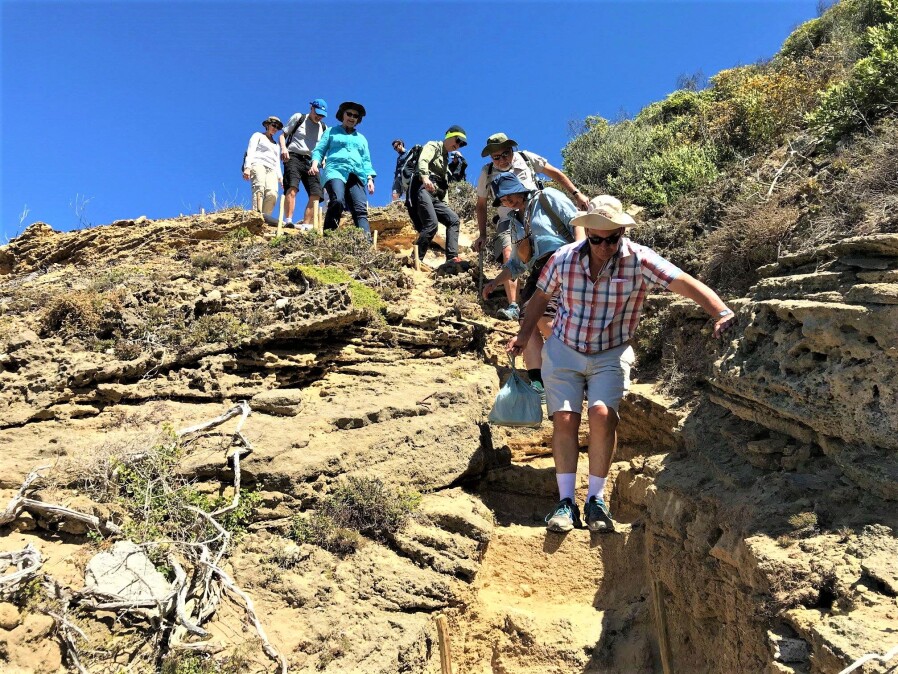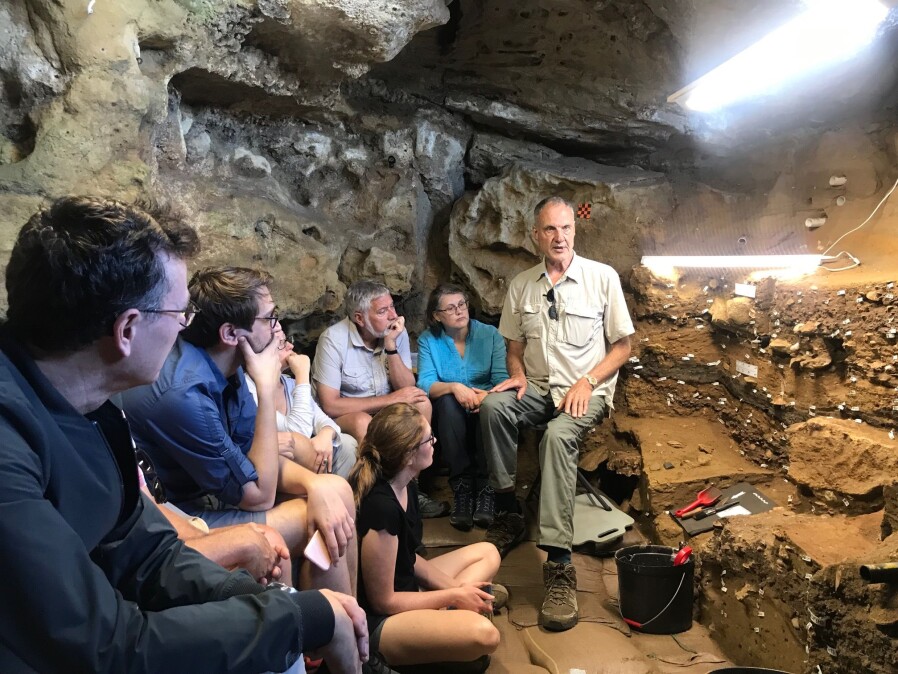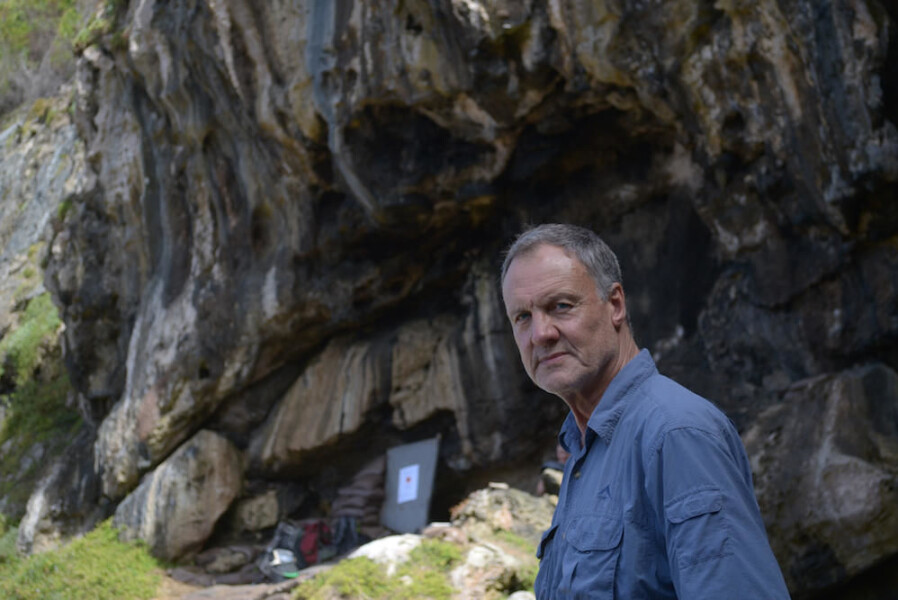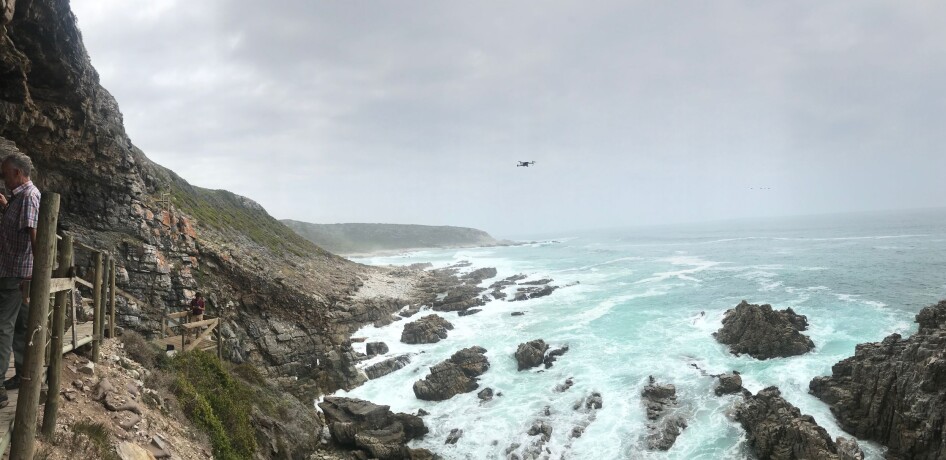This article was produced and financed by the University of Bergen - read more

He played here as a child. Then he became an archaeologist and found a now famous cave that answers questions of our past.
The archaeologists who found the World's oldest man-made drawing are back in Blombos Cave in South Africa, in search of new discoveries. Professor Henshilwood welcomes us to the cave to show us his team at work as they dig for clues that can tell us how early humans lived.
Blombos Cave is part of the Blombosfontein Nature Reserve and is located 300 km east of Cape Town, on the coast of the southern part of the Western Cape. The cave is located 100 metres inland from the coast and 35 metres above sea level at the foot of a cliff in the spectacular rocky landscape at Still Bay near Cape Town.
The trip to the cave is challenging if you are not accustomed to off-road driving. After the vehicles have been parked, we walk down a steep path cut into the hillside and arrive at Blombos Cave. The group consists of researchers from the University of Bergen (UiB), Germany, England and also UiB’s Rector, Dag Rune Olsen.

Secretive researchers
The interdisciplinary research team from the UiB's SapienCE Centre of Excellence is well underway with this year's dig. They look pleased, and maybe somewhat secretive.
Can they have found something? A spectacular object that rewrites our understanding of human prehistory? A new piece of evidence which helps to explain how our ancestors began to behave in recognisably human, recognisably “modern” ways?
Archaeologists often know when they have found something special, but many years may pass before they can fully explain the importance of the find. Specialised analyses and laboratory testing are necessary before they can explain, for example, how an object was used or how old it is.

Layer upon layer of stories
"We found the World’s oldest drawing in this area," says the South African archaeologist Christopher Stuart Henshilwood, pointing to the 73,000 year-old archaeological layer inside Blombos Cave. The excavations have cut down through the cave sediment, revealing numerous different coloured archaeological layers.
"Each of the archaeological layers tells a story about the people who have lived here," explains the professor.
He takes us back in time — to the time when our ancestors lived here in this cave. Henshilwood describes various items that have been discovered here. Each of them tell us something about how our ancestors began to use symbols to communicate with each other, much like people do today. In addition to the world's oldest drawing, researchers have found engraved ochre stones, seashell necklaces and tools made from bone and stone in Blombos Cave. Several of the discoveries have been published in prestigious journals such as Nature and Science.

Well preserved finds
“What is fascinating about this cave is that everything we find is very well preserved. People lived in this cave between about 100,000 and 70,000 years ago, but then sand filled the valley in front of the cave. It also filled the cave entrance and settled as a protective layer over everything that was buried here. The cave mouth remained blocked until about 2000 years ago, when the landscape had changed and made the cave opening visible again”, he explains.
It was Henshilwood himself who discovered the cave, which is located on the family’s property.
"My grandfather had a holiday home at Blombos, and I used to spend all my summer holidays here. I remember we used to find a lot of exciting objects on the beach, like shells and other things”, recalls Henshilwood and adds:
"Now we know that many of the things that we find are stone tools or and other artefacts created by the people who lived here”.
It was only after Henshilwood became an archaeologist as an adult, that he decided to scour the property in the hope that there would be a cave where he could start excavating.

Natural protection
Henshilwood and the other researchers believe that early humans lived in the cave for short periods of time, rather than inhabiting it permanently. The clearly defined cultural layers combined with the analysis of the sediment in each layer show that they do not belong to the same era, nor have they been mixed together by plant roots or burrowing animals as is often the case. Because of this, the cave must be excavated layer by layer so that we know which objects are the same age and belong together.
“We have to dig very carefully because the relationship between objects in a single layer tell a story about how people used the cave. Several of the layers we have uncovered have contained an entire life of the people who lived here. We find everything from food to art and tools that have been used. Using specialised analyses, we can find out what these people ate and how they have prepared the food, or we can try to understand how tools were made and what they were used for.
“It is a human trait to be able to express oneself through symbols. We do it every single day, through the way we talk, how we dress, by using special jewellery or through creating art. The finds from Blombos show that the people who have created them behaved in a very recognisably human manner - they were occupied with art and social communication and also had cognitive abilities that allowed them to develop different types of tools."
The SapienCE Drone
The researchers at SapienCE use advanced technology for reconstructing the past. Recently they acquired their own drone. PhD student Ole Fredrik Unhammer flies the drone and takes photos that he uses to create a 3D model of the landscape surrounding the cave.
"The aim is to reconstruct the landscape in order to be able to say something more about how it may have looked in the past," says Unhammer. The reconstruction of the landscape may help the team to understand the environment in which the Blombos inhabitants lived and the type of vegetation that might have been here. Unhammer also hopes that the drone can help the team discover new caves to excavate.
"It's still early in the project, but it's very exciting to discover a new way of working," says Unhammer.

Who we are – deep down
Rector Dag Rune Olsen is impressed by the way in which the researchers at SapienCE work.
“This is a brilliant example of world-class research! I am very proud of this interdisciplinary team which produces research of such a high international standard. I must also add that it is amazing to have the opportunity to learn more about how human behaviour has evolved, and how this can be seen through ancient symbolic and artistic expression. These are questions that concern us all, and that may be able to say something fundamental about what it means to be human.
The English version of this article is edited by Simon Armitage.

































